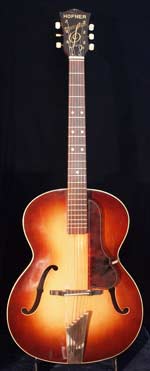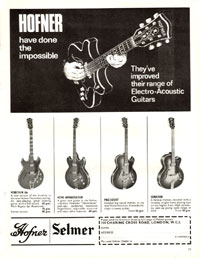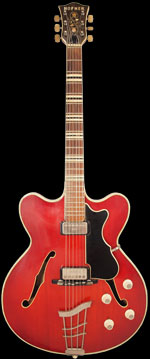

Hofner guitars and basses hold a very special position in the history of popular music; they were the guitars that so many influential British guitarists of the early 1960s were playing, Most notably of course, Paul McCartney of the Beatles, with his 500/1 Violin bass. And it's not hard to see why. Hofner guitars were of high quality. The hollow body Hofner guitar models have their own great feel and tone; woody and resonant. They are great guitars to play, and perhaps not surprisingly, lend themselves well to blues and jazz. It is no wonder that vintage Hofner guitars are highly desirable today, by collectors and musicians alike.
Karl Hofner started producing violins in 1887, adding other stringed instruments to the line soon after. He and his sons, Josef and Walter, built the business in Schonbach, Germany, building their first guitars there in the 1930s.
Coming from a tradition of Violin making did have a noticeable impact on the guitars they produced, and not just in body style, as in the aforementioned 500/1 bass. Players more used to other brands are often amazed at the light weight of hollow-bodied Hofner guitars and basses, and the superb "woody" tone. But one downside is the fact that they are less durable than many equivalent instruments; after all violinists don't thrash their instruments, and a typical Hofner can not take the beating that many rock guitarists like to mete out. Violins are held together with animal hide-based glue in order that necks can be steamed open and reset. After several decades, the joints of guitars built this way will often need regluing; most vintage Hofners have had or will need a neck reset. Likewise finishes, whilst beautiful looking, are not able to handle the wear and tear of decades of use. Vintage Hofners can be great functional instruments, but need to be handled with care to remain in tip-top condition.

1961 Hofner Congress acoustic guitar

1966 UK Hofner advertisement - see other vintage Hofner advertisements here
The Schonbach plant ceased instrument production during the second world war, and was closed shortly afterwards. Instrument production started again with a big new plant in another German town, Bubenreuth, opening in late 1950. Hofner's long history in orchestral stringed-instrument manufacture dictated the kind of guitars produced: well-built hollow bodies with set necks, many with hand carved tops, many acoustic; and many utilising the inlaying skills of Hofner's craftsmen. As the 1950s progressed numerous improvements were instituted; Hofner certainly kept up with the important developments in American guitars, and by the very end of the decade were producing thinlines, and fitting adjustable truss rods to all models. But guitar demand grew massively over the next two decades; both in Germany, but also increasingly worldwide. Sales were rising, buoyed, by the advent of rock 'n' roll and then beat music, and the Bubenreuth plant had to be extended on several occasions to keep up with production.

1962 Hofner Verithin thinline electric acoustic guitar have a closer look
Hofner guitars have always been popular in the United Kingdom. Hofner made special UK models like the President, Senator, Congress, Committee, Verithin and numerous others. They were similar in many ways to some European models. They were distributed in the UK and Commonwealth by Selmer and sold well in the late 1950s and very early 1960s, both as student and professional instruments. More expensive American guitars by Gibson, Gretsch and Guild were largely unavailable (or at least unaffordable) due to trade restrictions, at least until 1961, and at this point British guitar makers were unable to produce well-built hollow-body guitars, so Hofner initially had little competition.
Then, of course, there was Paul McCartney who had bought his 500/1 violin bass in 1961. He played this bass throughout his time with the Beatles, and despite having other basses available always came back to this; most notably using it on the famous Apple building rooftop concert of 1969.
One other big change in the 1960s was the strong demand for solid body guitars; in part due to the changing musical direction of the 1960s, but also the huge growth of student guitarists looking for cheaper instruments than the labour intensive hollow bodies. Original Hofner models like the V-series (V1, V2, V3) were followed by the Colorama, Super Solids and Galaxie guitars, all of which sold well to aspiring guitar players of the 1960s.
Solid bodies performed better at louder volumes, and as the 60s turned into the 70s, hollow guitars dropped out of fashion. But Hofner was facing problems. Highly respected manufacturers like Gibson and Fender had the professional end of the market all but sewn-up, whilst Asian manufacturers were producing high quality budget guitars very cheaply indeed. Hofner managed to keep flagship models like the violin bass, but was otherwise forced down the route of the Japanese manufacturers producing (admittedly not bad) copies of Gibson guitars.
Vintage Hofner guitars are quite collectable today, especially the hollow and semi-hollow models: the Hofner Club, Committee, President, Verithin etc, and their equivalent bass models. Higher end solid body Hofner guitars; ie those with set necks or significant electronics are gaining in desirability (early Colorama, and V1/V2/V3 for example). The earliest instruments with no adjustable truss rod, and the simplest pickups tend to be less sought than better-equipped early-mid 60s Hofner guitars. Some Hofner models were sold in very large numbers and are easily found at reasonable prices - the Hofner Congress acoustic for example (often with an added pickup) or later versions of the Hofner Colorama.
The most recent content posted to this site on vintage Hofner guitars:
 Scan of 1971 Selmer guitar catalogue showing the range of electric and acoustic guitars distributed by the company: guitars by Gibson, Yamaha, Selmer, Hofner and Suzuki. 1960s Selmer had always placed Hofner at the front end of their catalogues, no doubt these were the better sellers - but into the 1970s Hofner were slipping somewhat and only appear at the tail end of this publication, pride of place going to Gibson, and to a lesser extent Yamaha. In fact this is the last Selmer catalogue to include the many Hofner hollow bodies (Committee, President, Senator etc) that had defined the companies output for so many years - to be replaced in the 1972 catalogue by generic solid body 'copies' of Gibson and Fender models. A number of new Gibson models are included for the first time: the SG-100 and SG-200 six string guitars and the SB-300 and SB-400 basses.
Scan of 1971 Selmer guitar catalogue showing the range of electric and acoustic guitars distributed by the company: guitars by Gibson, Yamaha, Selmer, Hofner and Suzuki. 1960s Selmer had always placed Hofner at the front end of their catalogues, no doubt these were the better sellers - but into the 1970s Hofner were slipping somewhat and only appear at the tail end of this publication, pride of place going to Gibson, and to a lesser extent Yamaha. In fact this is the last Selmer catalogue to include the many Hofner hollow bodies (Committee, President, Senator etc) that had defined the companies output for so many years - to be replaced in the 1972 catalogue by generic solid body 'copies' of Gibson and Fender models. A number of new Gibson models are included for the first time: the SG-100 and SG-200 six string guitars and the SB-300 and SB-400 basses.
 Scan of 1968/1969 Selmer guitar catalogue (printed July 1968), showing the entire range of electric and acoustic guitars distributed by the company: guitars by Hofner, Gibson, Selmer and Giannini. Selmer were the exclusive United Kingdom distributors of Hofner and Gibson at the time, and this catalogue contains a total of 18 electric guitars, 7 bass guitars, 37 acoustics, and 2 Hawaiian guitars - all produced outside the UK and imported by Selmer, with UK prices included in guineas. This catalogue saw the (re-)introduction of the late sixties Gibson Les Paul Custom and Les Paul Standard (see page 69) and the short-lived Hofner Club 70. Other electric models include: HOFNER ELECTRICS: Committee, Verithin 66, Ambassador, President, Senator, Galaxie, HOFNER BASSES: Violin bass, Verithin bass, Senator bass, Professional bass GIBSON ELECTRICS: Barney Kessel, ES-330TD, ES-335TD, ES-345TD, ES-175D, ES-125CD, SG Standard, SG Junior, SG Special GIBSON BASSES: EB-0, EB-2, EB-3 - plus a LOT of acoustics branded Gibson, Hofner, Selmer and Giannini
Scan of 1968/1969 Selmer guitar catalogue (printed July 1968), showing the entire range of electric and acoustic guitars distributed by the company: guitars by Hofner, Gibson, Selmer and Giannini. Selmer were the exclusive United Kingdom distributors of Hofner and Gibson at the time, and this catalogue contains a total of 18 electric guitars, 7 bass guitars, 37 acoustics, and 2 Hawaiian guitars - all produced outside the UK and imported by Selmer, with UK prices included in guineas. This catalogue saw the (re-)introduction of the late sixties Gibson Les Paul Custom and Les Paul Standard (see page 69) and the short-lived Hofner Club 70. Other electric models include: HOFNER ELECTRICS: Committee, Verithin 66, Ambassador, President, Senator, Galaxie, HOFNER BASSES: Violin bass, Verithin bass, Senator bass, Professional bass GIBSON ELECTRICS: Barney Kessel, ES-330TD, ES-335TD, ES-345TD, ES-175D, ES-125CD, SG Standard, SG Junior, SG Special GIBSON BASSES: EB-0, EB-2, EB-3 - plus a LOT of acoustics branded Gibson, Hofner, Selmer and Giannini
 The Hofner Colorama was the name given by Selmer to a series of solid (and semi-solid) body Hofner guitars distributed in the United Kingdom between 1958 and 1965. The Colorama name actually applied to some quite different guitars over the period, but in 1960 it was a very light, semi-solid, set necked guitar with one (Colorama I) or two (Colorama II, as seen here) Toaster pickups. Although an entry-level guitar, it was very well-built, and a fine playing guitar; certainly a step up (at least in terms of craftsmanship) from many of the Colorama guitars that would follow, and a good deal of the guitars available in Britain circa 1960.
The Hofner Colorama was the name given by Selmer to a series of solid (and semi-solid) body Hofner guitars distributed in the United Kingdom between 1958 and 1965. The Colorama name actually applied to some quite different guitars over the period, but in 1960 it was a very light, semi-solid, set necked guitar with one (Colorama I) or two (Colorama II, as seen here) Toaster pickups. Although an entry-level guitar, it was very well-built, and a fine playing guitar; certainly a step up (at least in terms of craftsmanship) from many of the Colorama guitars that would follow, and a good deal of the guitars available in Britain circa 1960.
 The Hofner Committee was a truly beautiful guitar produced in Germany, primarily for the UK market. It was a large bodied (initially 17 1/2") guitar with a carved spruce top, available as an acoustic or electric guitar. By the early sixties the carved top was replaced with a laminate, and although still a very fine guitar, the earlier carved top examples, with frondose headstock (like the example shown here) are far more highly prized amongst musicians and vintage guitar collectors.
The Hofner Committee was a truly beautiful guitar produced in Germany, primarily for the UK market. It was a large bodied (initially 17 1/2") guitar with a carved spruce top, available as an acoustic or electric guitar. By the early sixties the carved top was replaced with a laminate, and although still a very fine guitar, the earlier carved top examples, with frondose headstock (like the example shown here) are far more highly prized amongst musicians and vintage guitar collectors.
 The President was produced by Hofner in Bubenreuth, Germany, specifically for Selmer, who distributed the brand in the United Kingdom, Australia, New Zealand, South Africa, and other commonwealth nations. The President was a hollow body electric acoustic, available as a full body or thinline, and with blonde or brunette finish. It was a great playing guitar that sold fairly well in the second half of the 1950s, throughout the 1960s, and into the very early 1970s. The example shown here is a full-body depth guitar in blonde - and as a 1965 guitar, one of the last to feature the rounded Venetian cutaway. From late 1965 until 1972, the President sported a sharp Florentine cut. Naturally, such an electric acoustic suggests jazz and blues, but many of the original British Hofner President players were part of the rock 'n roll, skiffle and beat scenes of the late 50s and early 60s.
The President was produced by Hofner in Bubenreuth, Germany, specifically for Selmer, who distributed the brand in the United Kingdom, Australia, New Zealand, South Africa, and other commonwealth nations. The President was a hollow body electric acoustic, available as a full body or thinline, and with blonde or brunette finish. It was a great playing guitar that sold fairly well in the second half of the 1950s, throughout the 1960s, and into the very early 1970s. The example shown here is a full-body depth guitar in blonde - and as a 1965 guitar, one of the last to feature the rounded Venetian cutaway. From late 1965 until 1972, the President sported a sharp Florentine cut. Naturally, such an electric acoustic suggests jazz and blues, but many of the original British Hofner President players were part of the rock 'n roll, skiffle and beat scenes of the late 50s and early 60s.
 The 1965/1966 Selmer guitar catalogue contained guitars by a number of different makers imported for the UK market, the most numerous being German-made Hofner electrics, acoustics and basses. There is also a fairly large Gibson section, but it by no means contains all instruments produced under that brand at the time. Other instruments featured include guitars and basses by Hagstrom and Futurama, and Brazilian acoustic guitars by Giannini. 44 pages, with UK pricing in guineas.
The 1965/1966 Selmer guitar catalogue contained guitars by a number of different makers imported for the UK market, the most numerous being German-made Hofner electrics, acoustics and basses. There is also a fairly large Gibson section, but it by no means contains all instruments produced under that brand at the time. Other instruments featured include guitars and basses by Hagstrom and Futurama, and Brazilian acoustic guitars by Giannini. 44 pages, with UK pricing in guineas.
 A closer look at a 1962 Hofner Verithin electric acoustic guitar, in translucent cherry red finish. The Verithin was Hofner's thinline model, produced in Germany for Selmer in the UK, and aimed at capturing the desire for the highly desireable, but largely unaffordable Gibson ES series thinline models. They were good quality, well-built, lightweight instruments, and very popular in early 1960s Britain.
A closer look at a 1962 Hofner Verithin electric acoustic guitar, in translucent cherry red finish. The Verithin was Hofner's thinline model, produced in Germany for Selmer in the UK, and aimed at capturing the desire for the highly desireable, but largely unaffordable Gibson ES series thinline models. They were good quality, well-built, lightweight instruments, and very popular in early 1960s Britain.
 The 1960 Selmer guitar catalogue featured a whole range of acoustic, electric semi-acoustic, and solid body guitars manufactured by Hofner. There were also a small number of Hofner-made (but Selmer branded) acoustic guitars, Futurama branded solid bodies, and a Futurama electric upright bass. From the very fine (and even shorter lived) Golden Hofner, to the budget Selmer 222 flat top. Monochrome, 32 pages
The 1960 Selmer guitar catalogue featured a whole range of acoustic, electric semi-acoustic, and solid body guitars manufactured by Hofner. There were also a small number of Hofner-made (but Selmer branded) acoustic guitars, Futurama branded solid bodies, and a Futurama electric upright bass. From the very fine (and even shorter lived) Golden Hofner, to the budget Selmer 222 flat top. Monochrome, 32 pages
$4000
$456
$1295
$5395
$4300
$2795
$4995
$4200
$150
$499